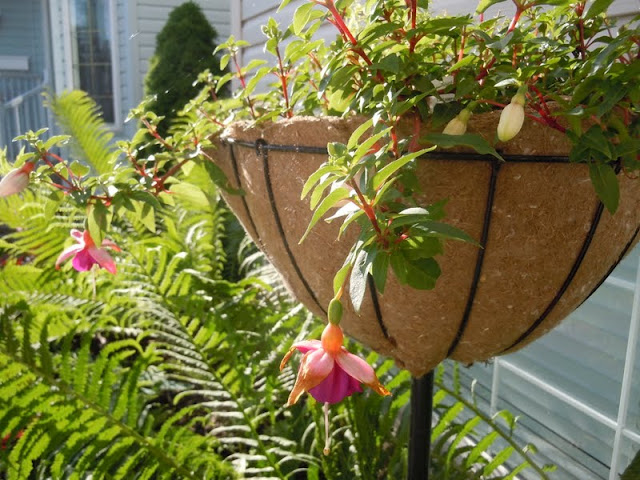 |
| My fuchsia planted in wire basket with asparagus fern in the center. |
 |
| Fuchsia, La Campenella. |
Last week my husband received a photo from one of his customers with a request for plant identification. Obviously he has been talking about my love of gardening, so this customer wanted information from me regarding the plant and whether or not the berries are edible. I identified her plant in question as fuchsia but had to research to determine if the berries were indeed edible. This article is the result of that inquiry. Perhaps it will entice you to give Fuchsia a try if you haven't already. Aren't they lovely? Another bonus - hummingbirds are attracted to them too!
"While the original pronunciation from the word's German origin is "fook-sya" /ˈfʊksja/, most English speakers tend to say "fyusha" /ˈfjuːʃə/. As a consequence, fuchsia is often misspelled as fuschia in English." (source Wikipedia)
Recent scientific publications, including articles written by Dr. Dennis E. Breedlove (University of California) and Professor Paul E. Berry (Wisconsin State Herbarium), recognize about 110 species of Fuchsia, divided into twelve sections. The majority of Fuchsia are native to South America, with a few naturally occurring through Central America to Mexico and several originating from New Zealand to Tahiti, the majority of the species being tropical or subtropical. Most grow as shrubs fro 8 inches to 13 feet tall. There is one New Zealand species, Fuchsia excorticata (Kotukutuku), which is a tree form growing 39-49 feet (12-15 metres) tall.
 |
| image from Wikipedia |
Depending on the species, fuchsia can be deciduous or evergreen with pendulous eardrop shaped blooms. Fuchsia flowers have four slender long sepals and for broader, shorter sepals. The coloration of the sepals varies from specie to specie, some bright red with purple petals, some purple with white petals; varying from whie to dark red, purple and orange, even some yellow tones. The fruit of the fuchsia is a small 5-25mm berry which is edible. Each berry contains several tiny seeds. The flavour has been compared to that of a grape spiced with black pepper.
Caring for your fuchsia
Outdoors, fuchsia grow best in a shady site. If you are growing indoors, select a hanging basket with good drainage and place in a sunny window that doesn't get overly hot as the fuchsia does not do well in the heat. If the plant droops, change location, selecting a site that is cool.
Fertilize regularly every couple of weeks. Water in the morning, on a regular routine. Fuchsias are thirsty and heavy feeders. If your planter drains too fast, consider adding a drainage tray so some of the water may then be absorbed from the bottom of the planter. Keep an eye on this though, as you don't want the soil to remain overly wet.
Fuchsias need cool temperatures to flourish, preferably below 65 F. They can tolerate higher temperatures if the humidity is high as well. Mist regularly to wash away any insects, such as white fly and red spider mite.
Overwintering:
Fuschias do not tolerate frost, so, before the first frost, spray the plant with insecticidal soap or hose down liberally. Let dry so it is no longer dripping and then bring indoors. From October to December, water sparingly, providing only enough moisture to keep the wood from shrivelling. In January move the plant to a very cool spot, with minimum temperature not cooler than 50 F. Once live "eyes" are visible, the signs of imminent new growth, trim to remove dead wood and to shape.
Remove the plant from its pot, gently removing the soil from the root ball, and re-plant in fresh fertile soil in the same size pot. Begin watering more often, as the plant grows. Pinch back a couple times prior to the end of May to encourage bushiness. At this point you may transplant to a larger pot or begin supplemental feeding once the roots have filled the soil.
Propagating:
Fuchsias may be grown from seed, sowing indoors in January or February. You may also propagate using soft green wood cuttings in February or March or August, being the best times. Cuttings of 3 inches are most successful if taken from suckers which start from the base of the plant. For cuttings, add horticulture sand to the soil mix to start them, keeping the temperature at a minimum of 60 F. Mist lightly if the cuttings show signs of wilt.
Note: all the photos in this posting are of my fuchsia with the exception of the one indicated from Wikipedia.
I'm joining Cottage Flora Thursdays for the first time ever.
Click on the underlined link to visit other participating gardens.




6 comments:
Beautiful! They look like little earrings!
Sue
xo
I wish I could grow Fuchsias here, but it's just too hot and humid. They are so beautiful.
Your fuchsia flowers are stunning! *great photos* I am visiting from Cottage Flora Thursday.
I didn't even know you could bring them in. I have 4 hanging baskets of them..I need to fertilize ...and change the hummingbird feeders..
Thank you so much for linking up to Cottage Flora Thursday's at Fishtail Cottage! Your fuchia's are so pretty. Thanks for the tip about bringing them in - didn't know that either... xoxo, tracie
I have always love the detailed beauty of the Fuchia flower but struggled to grow one in our California heat. We recently purchased a second home on the Oregon coast and happily I discovered a Fuchia the size of a tree growing on the property! It is starting to bloom and the blooms are amazing. I loved your photo looking up into the clouds ~ Jacque
Post a Comment